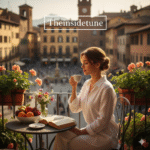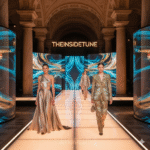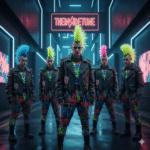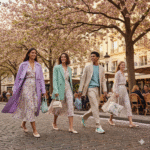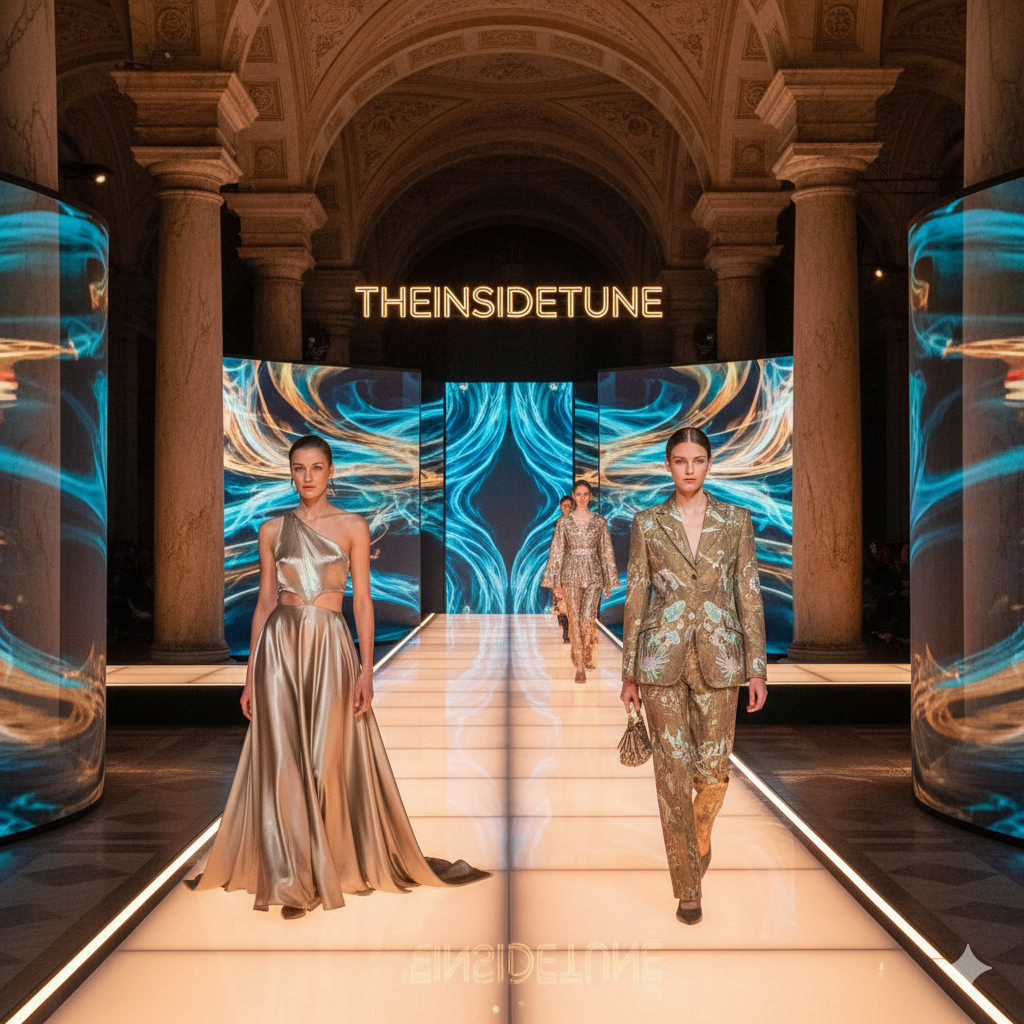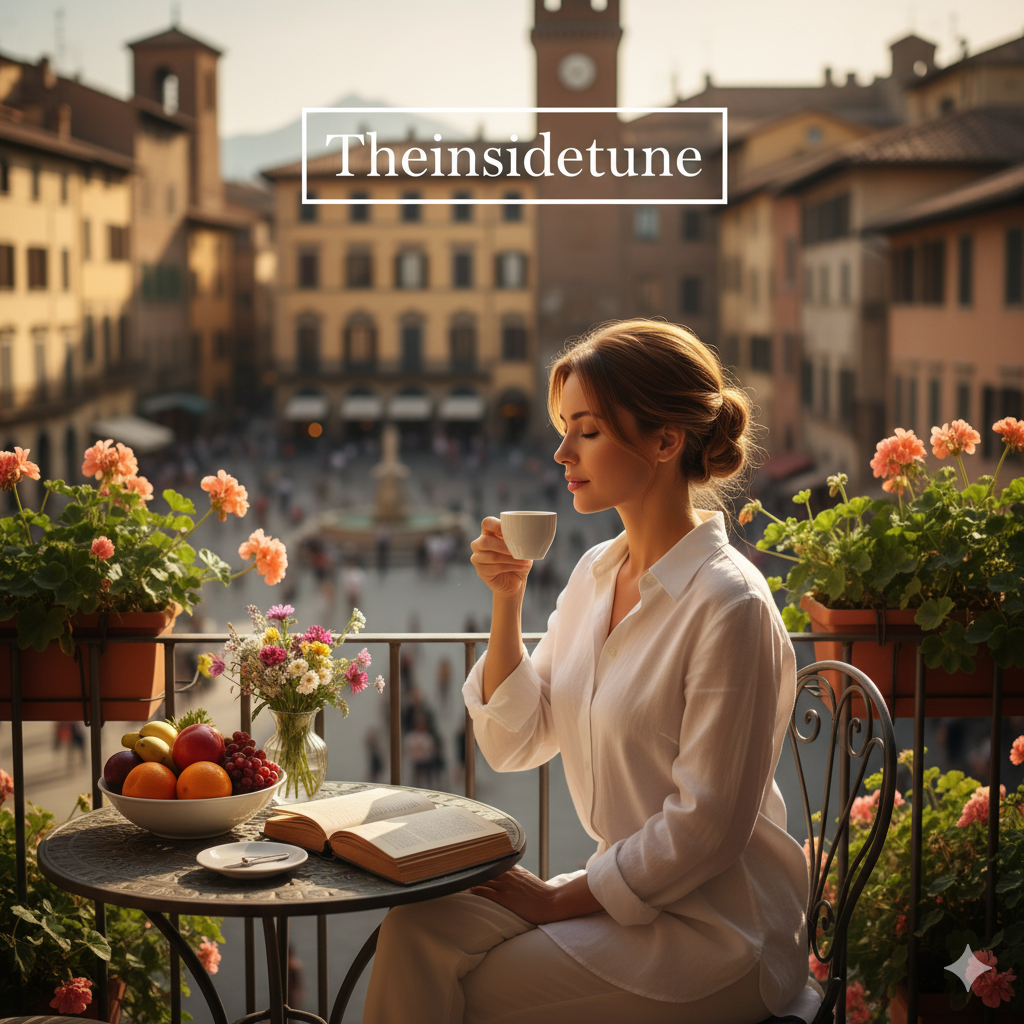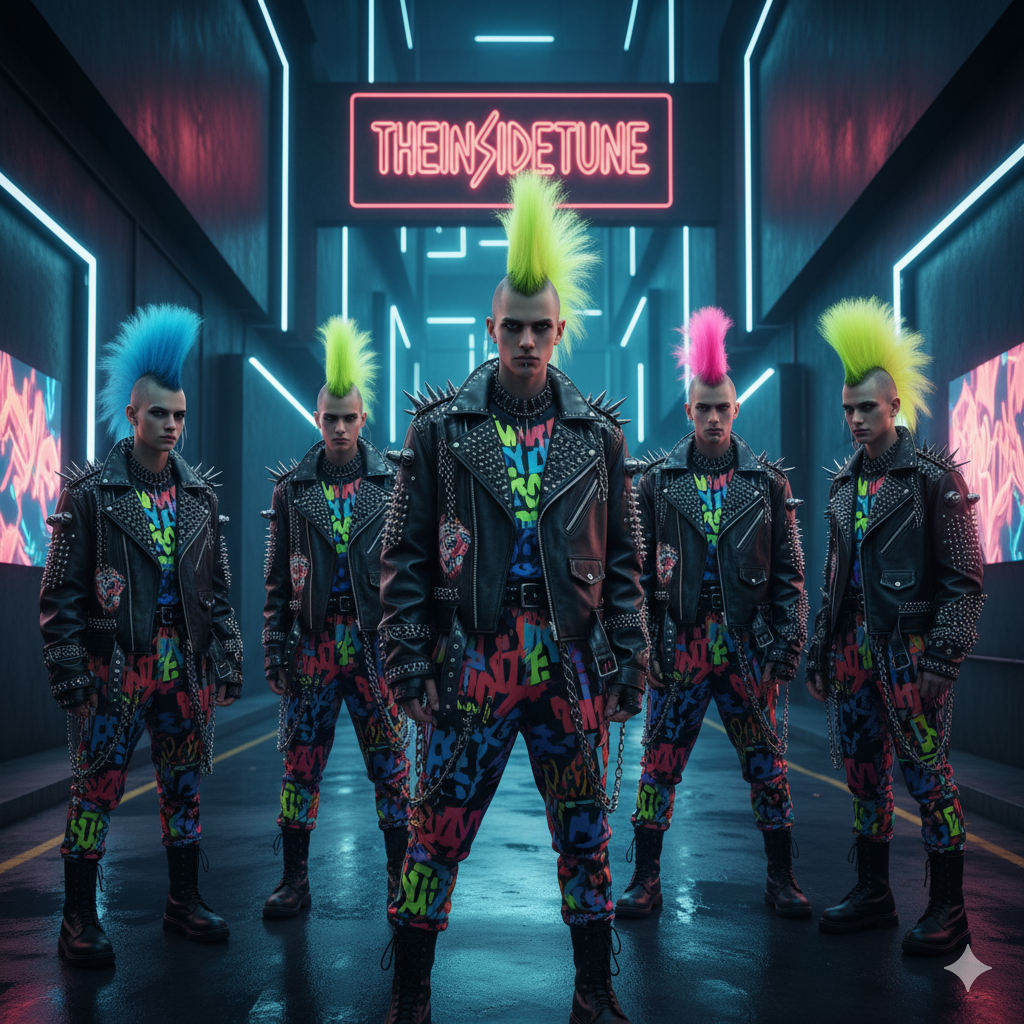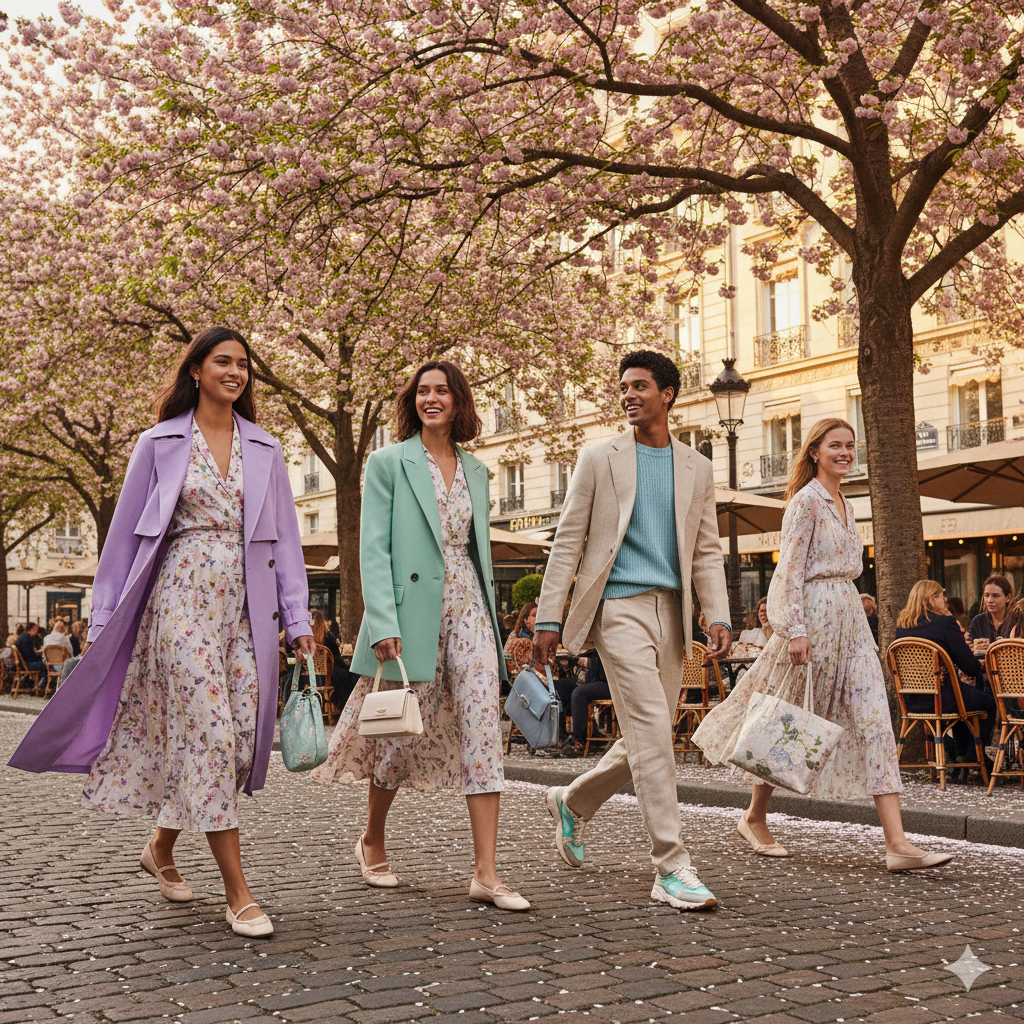Italian Fashion 2025; Iconic Italian Designers Leading — The Creative Minds Behind Modern Elegance
Italian designers have always had a magic touch — and in 2025, they’re proving it again.
From Gucci’s daring energy to Valentino’s quiet sophistication, each house tells a new story of style.
These visionaries are blending tradition with bold innovation, keeping Italy at the heart of global fashion.
Their work reminds us that true elegance isn’t just designed — it’s crafted with passion and purpose.
The Evolution of Italian Fashion
Italian fashion is more than just what people wear — it’s a way of life. It reflects confidence, creativity, and a love for beauty that runs deep in Italian culture. From the quiet streets of Florence to the busy runways of Milan, every piece made in Italy carries a story — one of passion, skill, and imagination.
A Quick Look Back
Italy’s fashion journey started decades ago, right after World War II, when the country began to rebuild its identity through art, design, and craftsmanship. Cities like Rome and Florence became the heart of luxury style.
Names such as Gucci, Valentino, and Versace shaped Italy’s global image. They mixed elegance with boldness — turning clothing into art. Their designs weren’t just about trends; they expressed personality and emotion.
Through the years, Italian designers built a strong connection between tradition and creativity. Whether it’s the perfect cut of a suit or the delicate lace on a gown, Italian fashion became a symbol of quality and individuality.
Stepping into 2025
Now, in 2025, Italian fashion continues to evolve while keeping its roots intact. The new generation of designers is blending craftsmanship with technology in exciting ways.
We’re seeing AI-assisted designs, 3D-printed fabrics, and even digital fashion shows — yet the core values remain the same: precision, beauty, and emotion.
Modern Italian brands are not chasing fast trends. They focus on creating pieces that last — clothing that feels personal, not mass-produced. This is what makes Italian fashion so different from many others around the world.
The Rise of Sustainable Style
One of the biggest changes in recent years is the shift toward sustainability. Italian designers are leading the way by using eco-friendly materials, ethical production, and slow fashion methods.
Small workshops across Italy still use handcrafting traditions that have been passed down for generations. These techniques are now combined with modern innovation — like plant-based dyes and recyclable fabrics — to reduce waste and keep fashion beautiful and responsible.
In 2025, sustainability isn’t just a trend in Italy — it’s a mindset. It’s about protecting the planet while preserving the country’s fashion heritage.
The Italian Touch Around the World
Italian fashion continues to inspire the world because of its unique mix of elegance and ease. You can spot it in the soft tailoring of a Milan suit, the flow of a silk dress in Paris, or the bold accessories seen in New York.
The Italian approach is simple: dress beautifully, but never overdo it. It’s confidence without effort — what Italians call “sprezzatura.” That natural, relaxed charm keeps Italian style timeless, even as trends come and go.
Why Italian Fashion Still Leads
In a world filled with fast fashion and constant change, Italy reminds us that true style takes time. The beauty of Italian fashion lies in its balance — tradition and technology, luxury and simplicity, art and practicality.
It’s not just about wearing designer labels; it’s about expressing who you are with confidence and grace.
Iconic Italian Designers Leading 2025
Italian designers have always shaped the way the world dresses — elegant, confident, and effortlessly stylish. In 2025, Italy’s creative energy is stronger than ever. Some designers continue to honor traditional luxury, while others push boundaries with bold ideas, new materials, and digital innovation. Together, they keep Italy at the top of global fashion.

Gucci — Modern Romance Meets Experimentation
Under the creative leadership of Sabato De Sarno, Gucci has taken a new, refined turn. The brand now focuses on clean lines, tailored silhouettes, and a quieter kind of luxury. The collections in 2025 bring a balance between classic elegance and modern youthfulness.
Gucci continues to play with genderless fashion — blurring lines between masculine and feminine — creating clothing that celebrates individuality. Its accessories, especially bags and loafers, remain timeless must-haves.
Style Tip: Pair a structured Gucci blazer with jeans and loafers for an effortlessly modern Italian look — polished but never too formal.
Prada — Minimalism with a Future Vision
Prada is all about intelligence and innovation. In 2025, Miuccia Prada and Raf Simons keep reinventing minimalism through unique textures and futuristic materials. Their designs are sleek but full of hidden details — simple shapes that make strong statements.
Prada’s 2025 collections focus on recycled fabrics, metallic finishes, and playful contrasts between soft and strong elements. Every outfit feels both modern and timeless — a perfect reflection of today’s Italy.
Style Tip: Try mixing a crisp white shirt with a metallic or structured skirt — a nod to Prada’s balance between practicality and bold creativity.
Dolce & Gabbana — Sicilian Soul and Digital Couture
Dolce & Gabbana never fail to celebrate Italy’s passion, culture, and color. Their 2025 line blends Sicilian glamour with digital-age innovation. Think embroidered corsets, vibrant prints, and new tech-driven couture pieces created with AI design tools.
The brand’s DNA — confidence, femininity, and celebration of curves — remains as powerful as ever. Dolce & Gabbana proves that tradition and modern technology can live beautifully side by side.
Style Tip: Add a floral statement piece — like a bold printed dress or corset top — and let it speak for itself. Confidence is the best accessory.
Valentino — The Poetry of Elegance
Pierpaolo Piccioli continues to make Valentino the definition of modern romance. His collections in 2025 highlight gentle silhouettes, artistic embroidery, and rich colors. Valentino stands for emotional design — it’s about feeling beautiful, not just looking stylish.
The brand’s soft approach to glamour connects deeply with the younger generation while staying loyal to its classic Italian roots.
Style Tip: Choose a flowing Valentino-inspired dress in a bold color like crimson or violet — simple makeup and minimal jewelry let the dress shine.
Fendi — Innovation in Every Stitch
At Fendi, luxury meets craftsmanship. The brand’s attention to detail is unmatched. Under Kim Jones, Fendi’s 2025 collections combine structure with softness — tailored coats, sleek leather, and creative cuts that flatter every shape.
Fendi’s use of digital tools and 3D design adds precision to its heritage of handwork. The brand is also a leader in sustainable fur alternatives and circular fashion.
Style Tip: Invest in a statement Fendi bag — it’s not just an accessory, it’s a piece of Italian design history.
Emerging Designers to Watch in 2025
Italy isn’t only about big names. A new wave of designers is bringing a fresh voice to fashion:
-
Marco Rambaldi – celebrates diversity and inclusivity through vibrant knitwear and modern love stories.
-
Annakiki – known for her futuristic, sculptural designs and use of AI in fashion design.
-
Sunnei – Milan-based brand redefining casual luxury with gender-neutral collections and eco-friendly materials.
These designers represent the future of Italian fashion — bold, conscious, and unafraid to challenge tradition.
Style Tip: Mix classic pieces with something experimental — a sculptural jacket or a bold knit — to capture that new Italian spirit.
A New Era of Italian Creativity
What makes Italian designers stand out in 2025 is their ability to evolve without losing authenticity. They understand that fashion is not just about looks; it’s about storytelling, identity, and emotion.
From high-end couture to streetwear-inspired luxury, Italian fashion continues to inspire the world by doing what it does best — combining beauty with meaning.
In short: The designers shaping Italy’s fashion scene in 2025 prove that true style never fades — it transforms. Whether through timeless tailoring or digital innovation, Italy continues to lead with imagination, passion, and heart.
Italian Models Who Define Beauty in 2025
Italian models have always brought something special to the fashion world — a mix of confidence, natural beauty, and effortless charm. They don’t just walk the runway; they tell a story with every look. In 2025, Italy’s top models and new rising stars are redefining what beauty means — more real, diverse, and authentic than ever before.

The Timeless Icons
Some Italian models have become legends because of their unique energy and presence.
-
Mariacarla Boscono remains a symbol of strength and individuality. Her long career shows how Italian elegance can evolve over time. She’s known for her striking look — dark eyes, bold attitude, and graceful movement — making her a true muse for designers like Givenchy and Fendi.
-
Bianca Balti, with her soft beauty and classic features, continues to represent the romantic side of Italian style. Her timeless appeal makes her a favorite for campaigns that celebrate femininity and grace.
-
Vittoria Ceretti, one of the most successful models of her generation, leads the Italian modeling scene today. In 2025, she’s the face of modern Italian beauty — fresh, confident, and global. She effortlessly moves between high fashion and everyday style, showing that beauty is about being natural and true to yourself.
These women remind the world that Italian beauty isn’t about perfection — it’s about emotion, character, and self-assurance.
The New Generation
A new wave of Italian models is making headlines across Milan, Paris, and New York. They bring diversity, energy, and a modern voice to the runway.
-
Greta Varlese stands out with her edgy features and artistic spirit. She’s known for working with brands that embrace creativity and individuality.
-
Matilde Rastelli has a soft, elegant presence that photographers love — she’s becoming a new face of minimalist Italian beauty.
-
Chiara Scelsi, with her curls and warm smile, represents the new face of Italian youth — confident, natural, and proudly herself.
These rising models show that Italian beauty now comes in many forms — from strong and bold to gentle and understated. What connects them all is that effortless charm Italians are known for.
Off-Duty Italian Style
Italian models are just as admired for their off-duty looks as they are for their runway walks. When they’re not modeling, their street style reflects a sense of ease — clean silhouettes, quality fabrics, and subtle accessories.
Think tailored jeans, leather jackets, neutral tones, and a pair of perfectly fitting boots. They dress simply but with purpose. There’s always that touch of sprezzatura — the Italian word for effortless style that looks unplanned but always works.
Style Tip: You can achieve this look by mixing structured basics with one statement piece — maybe a silk scarf, bold sunglasses, or a classic handbag.
How Italian Models Are Changing Beauty Standards
In 2025, beauty is no longer about one perfect look. Italian models are part of a global movement that celebrates individuality and self-expression.
They speak openly about authenticity, mental health, and sustainability — topics that were once rare in fashion. Many collaborate with eco-friendly brands or use their influence to promote local craftsmanship and ethical fashion.
This shift makes Italian fashion feel more real and relatable. It’s not just about outer beauty anymore; it’s about personality, confidence, and self-love.
The Spirit of Italian Beauty
Italian models have something that can’t be copied — that spark of warmth and self-belief. Whether they’re walking for Prada, posing for a Vogue cover, or sharing daily looks on social media, they reflect the heart of Italy’s fashion culture: beauty with soul.
They remind us that being stylish doesn’t mean being perfect — it means being yourself with confidence and grace.
In short: The models representing Italy in 2025 continue to inspire the world with their individuality and charm. They carry the same message as Italian fashion itself — timeless, expressive, and beautifully human.
Fashion Weeks & Events That Rule Italy
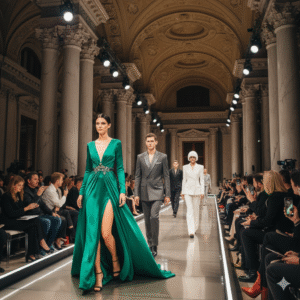
If Paris is about art and New York is about energy, then Italy is about emotion. Nowhere is that more visible than on its runways. Italian fashion events in 2025 are not just about clothes — they’re about creativity, storytelling, and the culture that makes Italy shine. From the glamour of Milan Fashion Week to the artistry of Florence’s Pitti Uomo and the elegance of AltaRoma, Italy continues to define how the world sees fashion.
Milan Fashion Week 2025 — The Heartbeat of Global Style
Every year, Milan Fashion Week turns the city into a stage for dreams. Streets fill with stylists, photographers, and designers, all rushing between shows that set the tone for the world’s fashion seasons. In 2025, the energy is more exciting than ever.
This year, Milan’s runways reflected three major themes:
-
Sustainability with substance – brands like Prada, Fendi, and Bottega Veneta showed how eco-conscious materials can look luxurious.
-
Genderless fashion – Italian designers continued to blur lines between menswear and womenswear, focusing on personal expression.
-
Digital meets couture – several houses integrated virtual fashion experiences and AI-driven styling tools, giving audiences a new way to connect with the collections.
One of the standout moments of Milan Fashion Week 2025 was Gucci’s “Quiet Luxury” collection — a mix of sharp tailoring, soft pastels, and understated glamour. Meanwhile, Dolce & Gabbana’s digital couture show turned heads by merging traditional embroidery with holographic storytelling.
Style Note: Milan Fashion Week is known for “smart simplicity” — outfits that look natural but are carefully styled. Think neutral tones, soft leather bags, and one bold accent like gold jewelry or patterned heels.
Pitti Uomo — The Soul of Italian Menswear
Held in Florence, Pitti Uomo is where the best of men’s fashion comes alive. It’s not just a trade fair — it’s a celebration of style, craftsmanship, and personality.
In 2025, Pitti Uomo showcased a perfect mix of classic tailoring and modern comfort. From linen suits in warm earth tones to minimalist sneakers paired with silk scarves, the looks reflected how Italian men blend tradition with modern lifestyle.
Designers like Brunello Cucinelli and Lardini focused on sustainability and timeless elegance, proving that true style doesn’t need to shout to be noticed.
Style Tip: Take inspiration from Pitti Uomo — mix formal pieces with relaxed touches. A blazer with casual trousers or loafers with jeans can create that effortlessly Italian balance.
AltaRoma — The Future of Haute Couture
AltaRoma, Rome’s fashion week, is all about creativity and emerging talent. In 2025, it became a platform for young designers who mix old-world craftsmanship with new technology. The collections felt personal, emotional, and refreshingly daring.
Designers showcased hand-embroidered gowns, eco-silk dresses, and AI-enhanced couture pieces that adapt to body shape and movement. It’s where tradition meets innovation — and it perfectly represents the direction Italian fashion is heading.
Style Note: AltaRoma is a reminder that true luxury is handmade. Even in the age of technology, the beauty of a hand-stitched gown or a one-of-a-kind piece can never be replaced.
Venice Film Festival — Where Fashion Meets Film
Though not a fashion week, the Venice Film Festival has become one of Italy’s most glamorous fashion stages. In 2025, the red carpet was filled with Italian designers — from Valentino’s soft romantic gowns to Armani’s sleek evening wear.
Celebrities, influencers, and stylists turned the event into a display of high fashion and cinematic elegance. The festival continues to show how deeply fashion and culture are connected in Italy.
Style Tip: Red carpet glamour doesn’t always mean extravagance. A well-fitted dress, polished hair, and simple makeup can speak louder than heavy styling — Italian beauty is always about grace.
How Italian Fashion Events Are Changing
One big shift in 2025 is how fashion weeks are becoming more inclusive and digital. Many shows are live-streamed to global audiences, and virtual reality experiences allow people anywhere in the world to “attend” the events.
At the same time, Italian fashion remains deeply human — the personal connection between designer and craftsman still defines its essence. Whether it’s a small artisan event in Tuscany or a high-glamour runway in Milan, every Italian fashion show tells a story about heritage, beauty, and the courage to innovate.
In short: Italian fashion events in 2025 prove that Italy remains the beating heart of style. Each show — from Milan’s global stage to Rome’s creative spotlight — celebrates what makes Italian fashion unique: emotion, craftsmanship, and imagination that never stop evolving.
Key Italian Fashion Trends of 2025
Italian fashion has always had a special rhythm — it never follows trends blindly. Instead, it shapes them with elegance and emotion. In 2025, that same Italian magic continues to inspire designers, stylists, and everyday fashion lovers. This year’s trends focus on comfort, creativity, and individuality — proving once again that true style never needs to shout to be noticed.
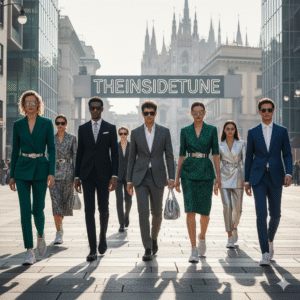
1. The Era of “Quiet Luxury”
One of the strongest trends in Italian fashion this year is quiet luxury — a move away from loud logos and flashy details toward subtle sophistication.
Brands like Gucci, Prada, and Tod’s are leading this trend with minimalist silhouettes, rich textures, and soft color palettes. Think neutral tones like cream, camel, taupe, and soft grey. These looks speak in whispers but leave a strong impression.
The Italian approach is all about quality over quantity — perfectly tailored pieces, buttery leather bags, and timeless accessories that you can wear for years.
Style Tip: Invest in wardrobe basics — a tailored blazer, a cashmere sweater, or leather loafers. Pair them with simple gold jewelry for that effortless Italian elegance.
2. Sustainable Fabrics and Slow Fashion
In 2025, sustainability isn’t just a buzzword in Italy — it’s a lifestyle. Italian designers are focusing more than ever on organic fabrics, recycled textiles, and ethical production.
Brands are introducing collections made from plant-based leather, natural dyes, and linen blends that are light, breathable, and eco-friendly.
Fashion houses are also promoting the idea of “buy less, choose better.” Consumers are encouraged to invest in long-lasting pieces instead of fast trends — a philosophy deeply rooted in Italian craftsmanship.
Style Tip: Look for labels that highlight local production and eco-friendly materials. A handmade Italian leather bag will always outlast a mass-produced one.
3. The Return of Tailoring
Tailoring is making a strong comeback — but with a modern twist. Italian designers are reinventing suits and structured outfits to be lighter, softer, and more flexible.
Women’s suits are now styled with cropped jackets, fluid trousers, and open collars. Men’s tailoring, too, has become more relaxed — unlined blazers, natural fabrics, and neutral tones that feel easy yet refined.
This trend captures the essence of Italian dressing: formal, but never stiff.
Style Tip: Try a soft, oversized blazer with a silk blouse or a plain tee — it adds structure without losing comfort.
4. Metallic and Futuristic Details
While Italian fashion is known for its timeless charm, 2025 also brings a futuristic side. Metallic tones, chrome accessories, and tech-inspired fabrics are trending in Milan’s streets and runways alike.
Designers like Annakiki and Prada are experimenting with shiny finishes, reflective surfaces, and even digital-print fabrics that change tones under different lights.
These pieces add a touch of modern energy to otherwise classic Italian looks.
Style Tip: Pair one metallic item — like silver boots or a gold mini bag — with a neutral outfit to make it pop without going overboard.
5. The Revival of Italian Street Style
Italian streetwear in 2025 is relaxed but still refined. Oversized shirts, cargo pants, and monochrome looks are trending — but Italians give them a polished twist.
You’ll often see tailored trousers paired with sneakers, or a casual hoodie layered under a trench coat. It’s casual elegance at its best — urban but chic.
Street style influencers in Milan are showing that comfort and sophistication can exist together.
Style Tip: Combine classic pieces with sporty touches — for example, a trench coat over joggers or sneakers with a midi dress.
6. Soft Colors and Textured Fabrics
This year, Italian designers are embracing soft, natural hues inspired by the Mediterranean — olive green, sky blue, sand beige, and coral pink.
Textures are also a highlight: lace, crochet, raffia, and linen are everywhere, giving outfits a warm, handcrafted feel. These fabrics connect fashion to nature and celebrate Italy’s artisanal heritage.
Style Tip: Mix light fabrics with soft shades — a linen shirt with cream trousers or a crochet top with a neutral skirt for that breezy Italian summer vibe.
7. Statement Accessories
In 2025, accessories play a huge role in Italian fashion. Bags are smaller but more artistic, shoes are bold yet comfortable, and eyewear remains a must-have piece of personal style.
Designers are exploring handcrafted details like woven leather, sculptural heels, and gold hardware that feels timeless.
Style Tip: A great pair of sunglasses or a structured mini bag can elevate any simple outfit. Italians know that sometimes the smallest details make the biggest statement.
8. The Digital Touch
Technology continues to influence how Italians design and wear fashion. Virtual try-ons, AI styling tools, and digital couture experiences are now part of everyday fashion culture.
Yet even with these changes, the Italian focus remains on emotion and authenticity. The digital world may inspire new looks, but the heart of Italian fashion — craftsmanship — still leads the way.
A Blend of Past and Future
Italian fashion in 2025 shows that tradition and innovation can live beautifully together. Whether it’s a hand-stitched suit, a 3D-printed handbag, or a perfectly draped linen dress, Italy continues to remind the world that fashion should feel good, look good, and last.
In short: The key Italian trends of 2025 are about simplicity, sustainability, and style that lasts. It’s a year of quiet confidence — where elegance, comfort, and creativity come together to shape the new face of fashion.
Italian Craftsmanship — The Heartbeat of Fashion Excellence
When people talk about Italian fashion, one word always comes to mind — craftsmanship. It’s not just about creating clothes or accessories; it’s about art, history, and love for detail. Every stitch, every cut, and every fabric choice tells a story that connects generations of Italian artisans to the modern fashion world.
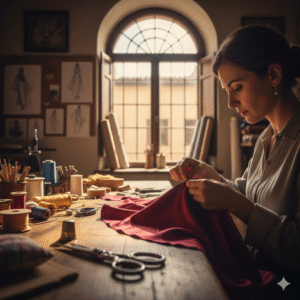
In 2025, this craftsmanship is not only alive — it’s thriving, blending centuries-old skills with today’s innovation and sustainability.
The Soul Behind the Stitch
Italian fashion houses are known for their devotion to la qualità — quality above all. Behind the luxury brands we adore — like Gucci, Fendi, Dolce & Gabbana, and Bottega Veneta — are skilled artisans who dedicate their lives to perfecting their craft.
Whether it’s hand-stitched leather bags in Florence, delicate lace from Burano, or tailored suits from Naples, every piece reflects years of expertise and a personal touch.
In Italy, craftsmanship is not just a job — it’s an identity. Families often pass down techniques for generations, ensuring that the art of making remains a proud cultural heritage.
Luxury Meets Sustainability
Modern Italian designers are proving that tradition and innovation can go hand in hand. In 2025, more brands are embracing eco-conscious materials and sustainable production methods without losing their luxurious feel.
For example:
-
Gucci’s Off the Grid Collection uses recycled and sustainable fabrics while keeping that signature Italian glamour.
-
Brunello Cucinelli continues to promote ethical fashion, emphasizing humanity and respect in production.
-
Smaller labels like Stella Jean highlight local artisanship while supporting cultural diversity and responsible sourcing.
This new wave of craftsmanship honors the planet while keeping Italian fashion’s artistic soul alive.
The Power of “Made in Italy”
The phrase “Made in Italy” isn’t just a label — it’s a promise. It stands for precision, authenticity, and timeless beauty. Around the world, it represents trust — the belief that something Italian will always feel special, from its texture to its design.
Even in 2025, this mark carries emotional weight. Shoppers are more conscious now — they want to know where their clothes come from, who made them, and whether they were crafted responsibly.
Italian fashion’s focus on transparency and quality gives it a unique edge in today’s global market.
Craftsmanship Beyond Luxury
What makes Italy’s fashion scene so fascinating is how craftsmanship touches every level — not just luxury. You’ll find incredible skill in local markets, family-owned boutiques, and emerging designers who handmake their collections in small workshops.
From Venetian shoemakers creating timeless leather pieces to Sicilian embroiderers turning traditions into wearable art — Italian craftsmanship is everywhere, breathing life into each creation.
Style Tip: If you ever buy Italian, focus on the feel — the texture of the leather, the smoothness of the silk, the weight of the fabric. Italians say you can always feel real quality — it doesn’t need a label to prove itself.
The Emotional Connection
What truly sets Italian craftsmanship apart is its emotion. Every artisan puts a part of their heart into what they make. There’s a deep pride in knowing that their work will be worn, loved, and remembered.
It’s fashion that isn’t just seen — it’s felt.
That’s the secret of Italian fashion: behind every masterpiece is a human story — of passion, patience, and perfection.
In Short
Italian craftsmanship continues to be the beating heart of the country’s fashion world. It’s where tradition meets innovation, and where luxury meets responsibility.
In 2025, as the world turns to technology and mass production, Italy reminds us that the most beautiful things are still made by hand — and made with love.
Modern Italian Street Style — How the Youth Are Redefining Fashion
Italian fashion may have deep roots in tradition, but today’s young generation is rewriting the rules. In 2025, Italian street style has become a powerful voice — bold, experimental, and full of personality. The new generation of Italians isn’t afraid to mix vintage with digital-age trends, luxury with streetwear, and local craftsmanship with global inspiration.
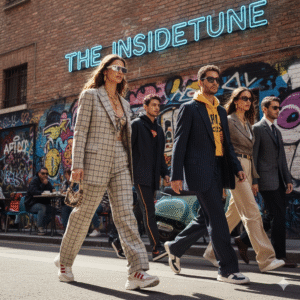
The streets of Milan, Rome, and Florence are now open-air runways where creativity comes alive. It’s not about showing off labels anymore — it’s about showing who you are.
The Rise of Street Couture
Italy’s Gen Z and Millennials have created what many call “street couture” — a blend of high fashion and streetwear that looks effortless yet artistic. You’ll see oversized blazers paired with sneakers, retro denim mixed with luxury bags, and unisex silhouettes that challenge old norms.
Unlike the past, where Italian style was mostly about polished perfection, 2025 is about freedom and authenticity. It’s cool to wear an heirloom jacket from your nonna with futuristic sunglasses. It’s all about balance — elegance meets edge.
Style Tip: Try mixing one structured Italian piece — like a tailored coat or leather loafers — with casual streetwear items such as cargo pants or a graphic tee. That mix is the essence of Italian street couture.
Key Italian Youth Brands Leading the Scene
A new wave of Italian designers and streetwear brands is shaping the country’s modern look. They blend sustainability, creativity, and inclusivity with Italian flair.
Some names to watch in 2025 include:
-
Sunnei – Known for playful shapes and bright colors, it brings art and architecture into everyday wear.
-
GCDS (God Can’t Destroy Streetwear) – A bold label that captures youth energy with humor, pop culture, and fearless design.
-
Palm Angels – Originally inspired by LA skate culture but with Italian luxury touches — it’s become an icon of modern cool.
-
MSGM – Famous for its vibrant prints and youthful optimism, MSGM represents the joyful side of Italian fashion.
These brands are not only defining what Italy wears — they’re exporting Italian street identity to the world.
Milan: The Street Style Capital
Milan has always been Italy’s fashion hub, but in 2025, its street style scene is buzzing more than ever. During Milan Fashion Week, photographers chase not just models but also local influencers, students, and creatives who turn sidewalks into runways.
From cropped leather jackets and tailored shorts to bold boots and oversized sunglasses, Milan’s streets are a masterclass in confident self-expression. The magic lies in how Italians make fashion look spontaneous — stylish without trying too hard.
That’s sprezzatura, again — that secret Italian charm that makes every outfit look naturally perfect.
The Social Media Influence
Platforms like Instagram, TikTok, and Pinterest have become the modern fashion stage for Italian youth. Instead of waiting for magazines to decide what’s in style, young Italians now create their own trends online.
You’ll see content creators blending classic Italian silhouettes with urban culture, music, and technology. Some even repurpose vintage luxury items — turning a scarf into a top or an old trench into a mini dress. It’s creative, sustainable, and very Italian.
Style Insight: Italian influencers are now promoting a “slow fashion” mindset — investing in fewer but better-quality pieces. They believe real style is not about owning more, but about owning what tells your story.
The Genderless Movement
One of the most beautiful shifts in Italian street style is its embrace of gender fluidity. Young Italians are exploring fashion beyond traditional boundaries. Unisex clothing, neutral tones, and minimalist cuts are common now, reflecting a wider cultural movement toward freedom and individuality.
Designers like Marco Rambaldi and Andrea Adamo are pioneers in creating gender-inclusive collections that still celebrate the Italian sense of form and beauty.
Sustainability as the New Cool
Today’s Italian youth care deeply about the planet. Many street style enthusiasts now prefer upcycled, handmade, or locally sourced pieces. Vintage stores in Milan and Florence are thriving, and thrift culture has become a statement of intelligence and creativity — not just fashion sense.
It’s about expressing values through clothes. Wearing a 10-year-old handmade jacket feels more meaningful than buying something trendy for a week.
The Message Behind the Look
At its heart, modern Italian street style is about confidence, individuality, and consciousness. It celebrates being bold but responsible, stylish but grounded.
The youth of Italy are showing the world that fashion can be both expressive and ethical — that you can look good while doing good.
In Short
Italian street style in 2025 is dynamic, diverse, and full of life. It’s a movement that reflects who young Italians are today — creative, proud of their roots, yet open to the world.
From the bustling alleys of Milan to the cozy corners of Rome, every outfit tells a story — one of courage, culture, and character. And that’s what makes Italian street style truly unforgettable.
Italian Fashion Icons & Global Influence
When you think of global style, Italian fashion icons instantly come to mind — people who don’t just wear clothes but live fashion. They embody grace, confidence, and that magnetic charm Italy is famous for.
From movie stars to designers and influencers, these icons have shaped the world’s view of elegance — not only through what they wear but through how they carry themselves.
In 2025, Italy’s influence remains stronger than ever, reaching red carpets, social media, and the wardrobes of trendsetters across the world.
Timeless Icons Who Defined Italian Elegance
Italy has gifted the world with personalities whose names are now synonymous with sophistication.
-
Sophia Loren, with her classic beauty and unapologetic confidence, remains a timeless inspiration. Her signature cat-eye makeup, fitted dresses, and radiant presence defined Italian femininity — bold yet graceful.
-
Monica Bellucci, the ultimate symbol of modern allure, carries that magnetic charm that blends sensuality and elegance in perfect harmony. She continues to inspire women to embrace their natural beauty and curves.
-
Donatella Versace, with her fierce creativity, has redefined fashion power. Her bold vision for Versace made the brand a global symbol of strength, glamour, and individuality.
These icons remind us that Italian style isn’t about perfection — it’s about presence. It’s about feeling confident, passionate, and unapologetically yourself.
Modern Icons Taking the World Stage
In today’s digital world, Italy’s influence travels faster than ever. A new generation of Italian celebrities and influencers is carrying that legacy forward — with their own modern twist.
-
Chiara Ferragni, one of the world’s top fashion influencers, has built an empire out of authenticity and style. From her Milan Fashion Week looks to her own brand, she shows how Italian flair can evolve in the digital age.
-
Vittoria Ceretti, one of the most in-demand supermodels globally, represents the new face of Italian elegance — confident, global, and effortlessly chic.
-
Lorenzo Zurzolo and Matilda De Angelis, rising film stars, are now celebrated as Italy’s new-generation icons who blend acting talent with a strong sense of style — effortlessly bringing Italian fashion to international red carpets.
Their looks are youthful, fearless, and rooted in that same Italian passion that’s always defined the country’s fashion DNA.
Italian Fashion on Global Red Carpets
From the Oscars to the Cannes Film Festival, Italian designers continue to dominate red carpet moments.
Every year, stars from around the world choose to wear Italian brands for one simple reason — no one captures drama, elegance, and emotion quite like Italy does.
-
Valentino gowns float down the carpet like poetry.
-
Dolce & Gabbana turns heritage into haute couture with romantic lace and Sicilian glamour.
-
Prada redefines sophistication with futuristic, intellectual edge.
-
Armani remains the ultimate name for timeless suits and minimalist luxury.
Italian fashion on the red carpet isn’t just about clothes — it’s storytelling through fabric. Each look carries that whisper of Italian artistry and soul.
The Global Power of “Italian Flair”
Italian flair — la bella figura — is about more than what you wear; it’s about how you carry yourself. The way Italians move, smile, and express confidence has become an international style statement.
This idea has shaped fashion weeks in New York, Paris, London, and Tokyo, inspiring designers to create looks that blend comfort with charisma. Even global streetwear brands now borrow elements of Italian tailoring and texture.
In essence, Italy doesn’t follow fashion — it sets the rhythm for it.
Cultural Exports: More Than Clothes
Italian influence goes beyond fashion shows and luxury boutiques. It’s in cinema, music, art, and design — all connected through the same sense of aesthetics and passion.
-
Movies like La Dolce Vita and The Great Beauty still inspire designers and photographers around the world.
-
Italian musicians and filmmakers often collaborate with fashion houses, blending culture and couture into one beautiful vision.
Even Italian cities — from Rome’s cinematic beauty to Milan’s modern elegance — shape the world’s fashion mood boards every year.
Why the World Loves Italian Style
There’s something universal about Italian fashion. It’s not just luxurious — it’s human. It celebrates real people, real shapes, and real confidence.
Italy teaches the world that fashion should feel alive — it should move, breathe, and tell your story.
That’s why global fashion lovers keep returning to Italian brands and icons. They don’t just buy products — they buy a feeling, a piece of that effortless Italian charm.
In Short
In 2025, Italy continues to shine as the heart of global style — not just for its designs but for its people. The country’s icons, both classic and modern, carry a message that never fades:
✨ Fashion is not about wearing trends — it’s about expressing who you are.
And that message, born on the streets of Rome and Milan, now echoes across the world.
The Future of Italian Fashion — Innovation, Technology & Tradition
Italian fashion has always been a symbol of artistry, emotion, and elegance. But in 2025, it’s also a symbol of innovation. The future of Italian fashion is being shaped by technology — yet it remains deeply rooted in tradition. This balance between heritage and progress is what keeps Italy at the heart of global style.
Fashion houses are no longer just making clothes — they’re designing experiences, powered by digital tools, sustainability, and creativity that goes beyond fabric and thread.
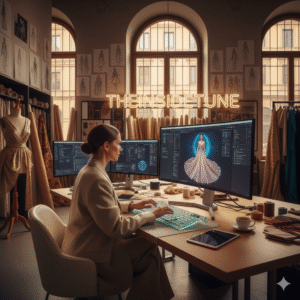
Where Craft Meets Code
For centuries, Italian fashion was built by hand — delicate stitching, hand-dyed fabrics, and artisanal design. Now, those same brands are embracing AI, 3D design, and digital fashion to reimagine what luxury means.
In Milan’s design studios, artisans and digital creators work side by side. They use 3D modeling to test patterns before cutting fabric, reducing waste and saving time — but still rely on the expert eye of the tailor to bring it to life.
Brands like:
-
Prada are exploring digital craftsmanship — using data and AI to predict style preferences while keeping their human creativity at the core.
-
Gucci launched its Vault Metaverse project, where digital fashion meets NFTs, showcasing how luxury can exist in both physical and virtual worlds.
-
Bottega Veneta continues to experiment with innovative materials that combine sustainability and cutting-edge design.
The message is clear: the future of Italian fashion is high-tech but human at heart.
Sustainability as the New Luxury
In 2025, sustainability isn’t just a trend in Italy — it’s a responsibility. The new generation of designers believes that beauty and ethics must coexist. From eco-leather bags to recycled silk fabrics, Italy’s creative minds are reinventing how fashion respects the planet.
-
Brunello Cucinelli calls it “Humanistic Capitalism” — valuing both people and nature.
-
Stella Jean champions diversity and ethical production, collaborating with artisans in developing countries.
-
Salvatore Ferragamo invests in sustainable innovation, experimenting with regenerated nylon and biodegradable materials.
These designers prove that the real luxury now lies in transparency, longevity, and care — not in overproduction.
Digital Fashion Weeks & Virtual Runways
Milan, once defined by its grand catwalks and flashing cameras, now leads a new era of digital fashion presentations.
Hybrid shows blend physical and virtual experiences — think holographic displays, live-streamed runways, and virtual fitting rooms where you can try on outfits using augmented reality.
This digital shift makes Italian fashion more accessible. Fans from anywhere in the world can now step inside Milan Fashion Week virtually — feeling part of the glamour without leaving home.
Even traditional houses like Armani and Valentino have embraced digital storytelling, turning each collection into a cinematic experience. It’s not just fashion — it’s art in motion.
The Rise of Smart Textiles
Technology isn’t just changing how clothes are designed — it’s changing what they can do. Italian designers are investing in smart textiles that adapt to the body, regulate temperature, and even monitor wellness.
Imagine wearing a jacket that adjusts warmth based on your environment or a dress that changes shade with light exposure — these aren’t sci-fi dreams anymore.
Italian brands are proving that fashion can be intelligent without losing its soul.
Supporting Local, Thinking Global
Despite all the innovation, Italy remains deeply proud of its local roots. The “Made in Italy” identity still drives every design, but the focus is shifting toward global collaboration.
Designers are connecting with artisans from Africa, Asia, and South America to create hybrid pieces that celebrate diversity while maintaining Italian excellence.
This cultural exchange keeps Italian fashion fresh, relevant, and globally loved.
Educating the Next Generation
The future also depends on nurturing new talent. Institutions like Istituto Marangoni, Polimoda, and Accademia Costume & Moda are training young designers to think beyond trends — to innovate responsibly.
Students now learn AI-driven design, sustainable fabric sourcing, and digital marketing, blending creativity with business awareness.
This education ensures Italy’s fashion legacy continues to evolve — guided by passion, intelligence, and heart.
Tradition That Moves Forward
Even as Italian fashion embraces AI, sustainability, and smart textiles, its foundation stays the same — beauty, emotion, and craftsmanship.
Technology may redefine how garments are made and sold, but it will never replace the soul behind them. The hands that cut, sew, and design in Italy still work with love and purpose — that’s what keeps Italian fashion timeless.
In Short
The future of Italian fashion is a harmony between innovation and tradition. It’s digital yet handmade, sustainable yet luxurious, forward-looking yet emotionally rich.
As Italy steps into this new era, it continues to prove that fashion isn’t just about keeping up with change — it’s about leading it with passion, artistry, and authenticity.
In 2025 and beyond, Italian fashion will remain what it has always been — a beautiful conversation between the past and the future.
Fashion Travel in Italy — Exploring Style Cities & Shopping Destinations
Italy isn’t just a country; it’s a living fashion experience. Every city, every cobblestone street, and every piazza tells a story of style.
For anyone who loves fashion, traveling through Italy is like walking through a living runway — from Milan’s polished elegance to Florence’s artisan workshops and Rome’s timeless glamour.
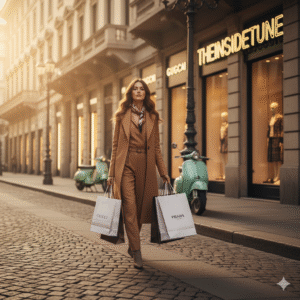
In 2025, “fashion travel” has become a major trend — where tourists don’t just visit monuments, they explore boutiques, ateliers, and local craftsmanship. Because in Italy, fashion isn’t confined to stores — it’s everywhere you look.
Milan — The Capital of Modern Fashion
Milan is the beating heart of Italian style. Known as the Fashion Capital of Europe, it’s where global trends are born and where timeless luxury lives.
Start your journey at the Quadrilatero della Moda (Fashion Quadrilateral) — the golden district that hosts the world’s most luxurious stores, including Prada, Gucci, Armani, Versace, and Dolce & Gabbana. Each window here feels like a work of art.
But Milan isn’t only about luxury. Walk through Corso Como, Brera, or Navigli, and you’ll find creative boutiques, concept stores, and vintage gems — the places where fashion meets street culture.
And if you’re lucky enough to visit during Milan Fashion Week, the whole city transforms into a living catwalk — with models, stylists, and fashion lovers filling the streets in dazzling style.
Must-Visit Spot: 10 Corso Como — a blend of fashion, art, and café culture, perfect for anyone who loves creativity with coffee.
Florence — The City of Craftsmanship
If Milan is modern, Florence is soulful. It’s the birthplace of the Renaissance and the home of artisanal fashion. Here, you can feel the deep connection between craftsmanship and culture.
Visit the Oltrarno district, where small workshops still handcraft leather bags, shoes, and jewelry. Watch artisans create with passion — it’s a rare sight in today’s world of fast fashion.
Florence is also the home of legendary houses like Salvatore Ferragamo and Gucci. The Gucci Garden Museum near Piazza della Signoria is a must-see — a beautiful blend of fashion history and modern art.
Insider Tip: If you love leather, don’t miss the San Lorenzo Market. The smell of genuine Italian leather alone will make your trip unforgettable.
Rome — Glamour Meets History
Rome is fashion with a heartbeat. It’s where ancient beauty meets cinematic elegance. Strolling down Via dei Condotti feels like walking through an open-air museum lined with luxury stores — from Bulgari to Fendi and Valentino.
What makes Rome unique is its effortless blend of old and new. You can sip espresso near the Spanish Steps, shop at high-end boutiques, then discover independent designers in Monti or Trastevere, areas full of young creative energy.
Fashion here isn’t just about clothes — it’s about living beautifully, la dolce vita style.
Style Tip: When in Rome, embrace elegance — think linen, neutrals, and gold accessories. Romans dress with confidence, never excess.
Venice — The City of Art and Couture
Venice brings a dreamy, romantic touch to Italian fashion. Known for its historic textiles and luxury masks, it’s a place where tradition meets imagination.
Many high-end designers draw inspiration from Venice’s soft colors, flowing silks, and magical light.
During the Venice Film Festival, the red carpet sparkles with Italian designers’ creations. It’s one of the few events where fashion and cinema merge so gracefully.
Hidden Gem: Visit Atelier Nicolao to see how Venetian costumes are made — a glimpse into fashion’s theatrical past.
Naples — Tailoring and Personality
Naples may be less talked about in mainstream fashion, but insiders know it as the home of the world’s best tailoring. Neapolitan suits are famous for their precision, lightweight fabrics, and perfect fit.
Small tailoring houses like Kiton and Cesare Attolini have kept this art alive, proving that real luxury lies in detail and handwork.
The city’s streets also have a unique energy — colorful, passionate, and full of style that feels personal and unfiltered.
Must-Experience: Visit a Neapolitan tailor’s studio and watch them hand-cut fabric — it’s pure magic for fashion lovers.
Shopping Tips for Fashion Travelers
-
Go beyond the big brands — explore local boutiques and workshops; that’s where you’ll find Italy’s heart.
-
Invest in quality over quantity — Italian fashion is built to last, whether it’s shoes, leather, or tailoring.
-
Ask about the story — Italians love to share how and where things are made. Every purchase has a story behind it.
-
Visit during sale seasons (January & July) — when luxury becomes a little more affordable.
-
Always look for “Made in Italy” — it’s not just a label, it’s a mark of authenticity and artistry.
Fashion Beyond Shopping
Fashion travel in Italy isn’t only about buying; it’s about experiencing. It’s sipping espresso outside a boutique in Milan, walking through Florence’s ateliers, or watching models cross Rome’s ancient bridges in couture gowns.
It’s feeling the texture of real silk, the scent of Italian leather, and the warmth of artisans who pour their heart into every creation.
In Italy, fashion isn’t something you wear — it’s something you live.
In Short
To explore Italy through fashion is to explore beauty, history, and passion all at once.
From luxury houses to hidden artisan studios, every stop reveals another layer of the country’s creative soul.
In 2025, Italy continues to prove why it’s not just a fashion destination — it’s a fashion dream.
A place where elegance meets emotion, and where every traveler leaves a little more stylish than when they arrived.
The Future of Italian Fashion— Innovation Meets Tradition
Italian fashion has always been more than just beautiful clothes — it’s a statement, a story, and a way of life. And as we move deeper into 2025 and beyond, one thing is clear: the future of Italian fashion lies in its ability to balance innovation with tradition.
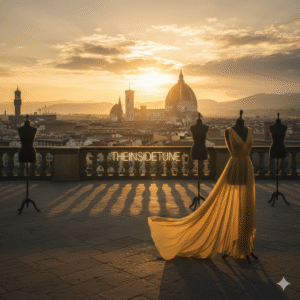
The charm that made Italy a fashion capital decades ago still lives on, but it’s now infused with fresh energy, digital creativity, and a deep respect for the environment.
Technology Meets Tailoring
Today’s Italian fashion houses are proving that technology can enhance artistry, not replace it. From AI-assisted design to 3D printing, brands are embracing digital tools while keeping the craftsmanship that defines them.
-
Prada and Gucci use AI to predict style trends and manage sustainable production.
-
Dolce & Gabbana is exploring digital fashion shows and NFT-based collections that blend real and virtual luxury.
-
Emerging designers use 3D design software to visualize fabrics, cuts, and colors before they even touch a needle.
Yet, even with all these digital advancements, one thing remains constant — the Italian belief that fashion begins with the hands. No machine can replicate the touch, precision, or intuition of a skilled artisan.
Sustainability as the Core Value
The next generation of Italian designers is fiercely committed to protecting the planet.
They are redefining luxury by focusing on ethically sourced materials, slow fashion, and timeless design rather than disposable trends.
You’ll see:
-
Upcycled leather and repurposed textiles in Milan’s boutique collections.
-
Local production in Florence to reduce carbon footprints.
-
Natural dyes and organic fabrics replacing synthetic materials.
This shift shows that luxury and responsibility can exist in perfect harmony — a philosophy that’s reshaping Italy’s entire fashion landscape.
The Rise of Young Designers
The heart of Italy’s fashion future beats in its young creatives — bold, visionary talents who aren’t afraid to challenge tradition while still honoring it.
Designers like Marco Rambaldi, Arthur Arbesser, and Giuliva Heritage are crafting a new image for Italian fashion — one that’s inclusive, gender-fluid, and expressive.
They mix vintage charm with futuristic flair, telling stories that connect Italy’s past elegance to a more diverse and digital future.
These voices represent a new Italy — one that’s creative, conscious, and global.
Global Influence and Cultural Fusion
Italian fashion continues to inspire the world. But what’s even more exciting is how it’s evolving by embracing global collaboration.
From Asian markets to Middle Eastern luxury buyers, Italian brands are tailoring designs for diverse cultures while keeping their identity intact. This exchange of ideas is enriching fashion on both sides — bringing new patterns, silhouettes, and stories into the Italian style language.
In 2025, fashion isn’t just about wearing Italian — it’s about feeling Italian anywhere in the world.
Fashion with a Soul
The future of Italian fashion will always hold onto one timeless truth — style is about soul.
It’s about passion, self-expression, and the pursuit of beauty that never fades.
No matter how digital or fast the world becomes, Italy will continue to remind us that fashion is personal, emotional, and deeply human. It’s not just about clothes — it’s about confidence, culture, and connection.
In Essence
Italian fashion’s future shines bright because it’s grounded in something eternal — the love for art, beauty, and craftsmanship.
By blending innovation with heritage, and sustainability with luxury, Italy continues to lead not just in style but in spirit.
The next chapter of Italian fashion isn’t just about what we wear — it’s about how we live, create, and care. And that’s a story the world will always look to Italy to tell.

